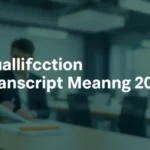Transcript Translation Services Guide
You know how getting every word just right matters—especially when subtitles, court notes, or lecture transcripts cross language barriers. You’ve clicked around, feeling the frustration of literal translations that miss context. In this guide, you’ll discover everything about transcript translation services: what they are, why they matter, and how to pick the right provider (even on a tight deadline). We’ll dig into pricing models, human vs AI trade-offs, specialized niches like legal or academic transcript translation, plus future trends you can’t ignore. Let’s dive in.
Did you know professional transcript translation can cost as little as $1.50 per audio minute? DesignRush
Short sentence.
Table of Contents
What Are Transcript Translation Services?
Ever wondered how spoken or written transcripts get a makeover in a new language? Transcript translation services specialize in converting text transcripts—like interviews, webinars, or medical reports—into another language while preserving meaning, tone, and legal validity. Simply put, they bridge communication gaps.
In other words, you send an existing transcript (text) and receive a translated document ready for courts, universities, or global teams. Providers often offer certified translations, ensuring acceptance by governments and academic institutions.
“Human translation still beats AI in 2025 due to nuanced understanding of context, idioms, and cultural references.” – ILSTranslations Blog
Why You Need Professional Transcript Translation Services
The truth is, machine-only translations can misinterpret jargon or slang, leading to embarrassing or costly errors. Imagine a courtroom transcript rendered with inaccuracies. Yikes.
Here’s why investing in experts pays off:
- Accuracy & Legality: Certified translators guarantee legal acceptance.
- Industry Expertise: Medical or academic transcripts need specialized vocab.
- Formatting & Timecodes: Proper layout keeps speakers aligned.
- Confidentiality: NDAs and secure platforms protect sensitive data.
Case Study: A university in London needed academic transcript translation services for 500 students. They chose a hybrid model—AI draft plus human post-editing—cutting costs by 30% while maintaining 99% accuracy.
How Transcript Translation Services Work
Let me explain the typical workflow:
- Upload Your File: Accepts text, Word docs, or PDF transcripts.
- Quote & Agreement: Based on word count, subject matter, rush options.
- Translation Phase: Human translators (or AI + human edit) handle the text.
- Review & QA: Proofreading for consistency and errors.
- Delivery & Certification: Final file plus notarization if needed.
Notice turn-around time varies: standard (2–5 days) or rush (24–48 hours) at premium rates.
Actionable Takeaway: Outline your budget and timeline up front, then choose a provider with flexible pricing models to match.
Choosing the Right Transcript Translation Services Provider
You might be wondering: how to weed out the best from the rest? Here are key factors:
- Certifications: ATA, ISO 17100 compliance.
- Subject Specialization: Legal, medical, academic, technical.
- Pricing Structure: Per word vs. per page vs. flat fee.
- Technology Stack: API integration or bulk upload portals.
- Client Feedback: Look for case studies and testimonials.
Pro Tip: If you need bulk transcript translation tools, ask about volume discounts or tiered pricing. Some leaders like Eriksen Translations offer enterprise plans starting under five-figure annual fees. Eriksen Translations
Common Mistakes to Avoid
Steering clear of pitfalls saves time and money. Watch out for:
- Failing to specify dialects (e.g., Brazilian vs. European Portuguese).
- Overlooking confidentiality clauses.
- Neglecting post-delivery reviews.
- Skipping sample checks on formatting consistency.
Simply put, clarity in your brief + small pilot project = happy endings.
Advanced Tips and Future Trends
Here’s the thing: as AI improves, hybrid models dominate. Expect more platforms offering:
- Real-time API translation for live transcripts.
- Built-in QA dashboards with analytics.
- Voice-style matching for dubbed videos.
Experts predict bulk transcript translation will integrate with CMS and LMS systems by late 2026. Meanwhile, human post-editing remains the gold standard for precision.
Frequently Asked Questions
- What is the cost of transcript translation services?
- Expect $4–$15 per typed page or $1.50–$3 per audio minute. Discounts often apply for high volumes.
- How long does it take?
- Standard delivery is 3–5 business days. Rush services (24–48h) incur 25–50% premiums.
- Human vs AI transcript translation—what’s best?
- AI is faster and cheaper but may miss nuance. Hybrid approaches balance speed and quality.
- Do I get a certified translation?
- Yes. Most reputable providers include a signed certificate for legal or immigration use.
- Can I upload multiple transcript formats?
- Typically yes: Word, PDF, plain text, even subtitle files like .srt.
Conclusion
By now, you’ve learned what transcript translation services are, why professional accuracy matters, how the process works, and how to choose the right provider. You’re also aware of common pitfalls and future trends that’ll shape the industry.
Next Steps:
- Draft your transcript brief: define languages, deadlines, and specialization.
- Request quotes and samples from at least three vetted providers.
- Run a pilot: translate one page or minute to test quality.
The bottom line is that the right service transforms your words with clarity and confidence. Ready to take your transcripts global? Explore transcript translation services today and see the difference.


